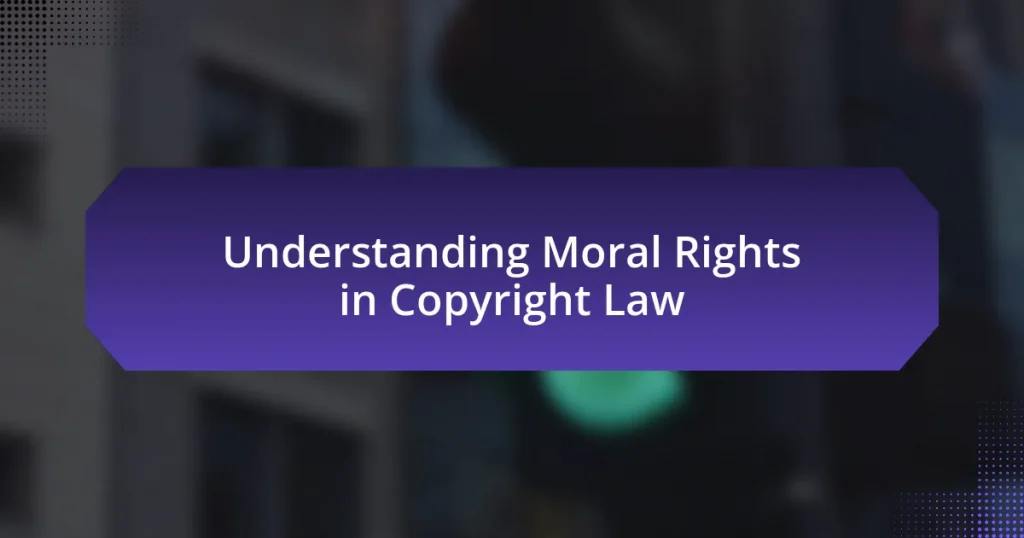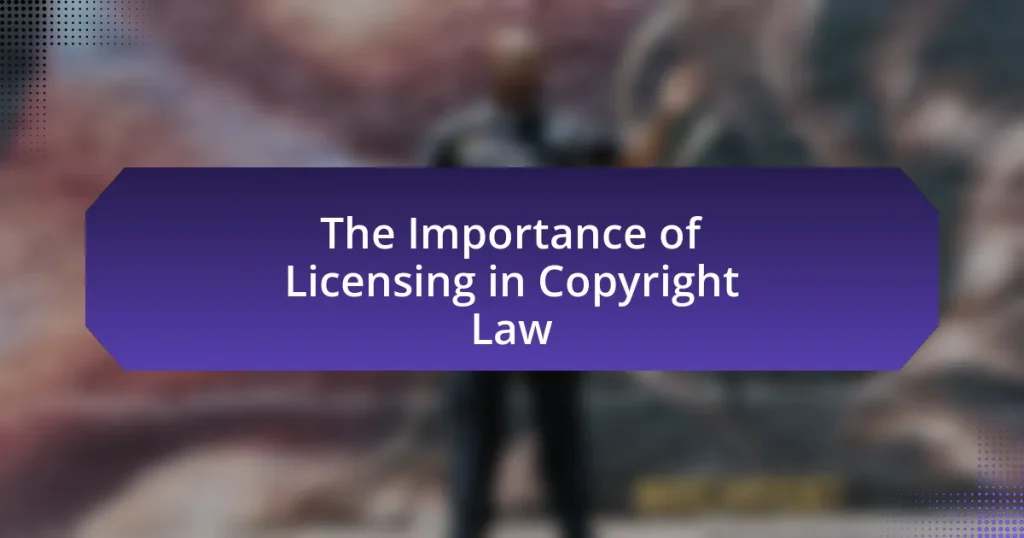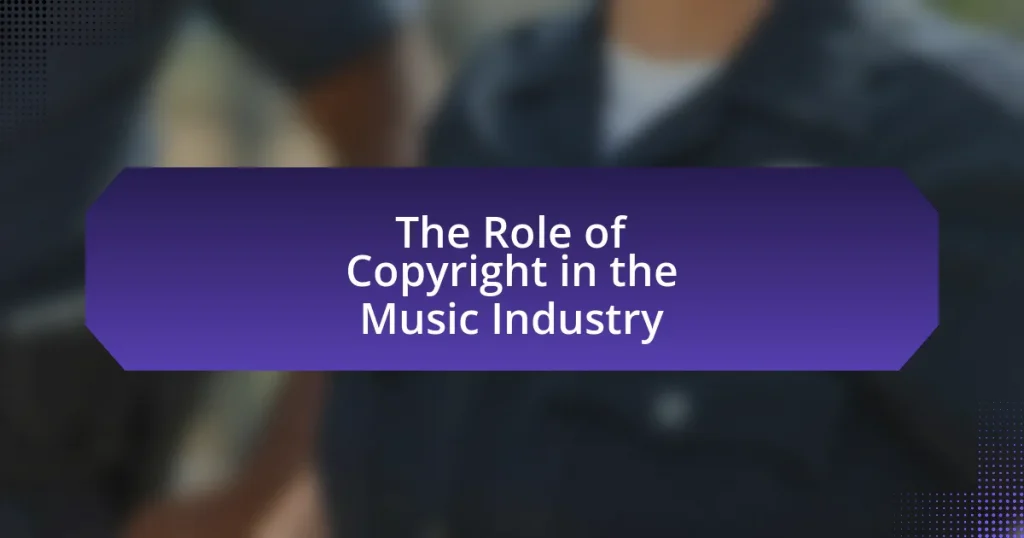Copyright law is a legal framework that grants creators exclusive rights to their original works, such as literature, music, and art, for a specified duration, typically the life of the author plus 70 years. This article explores the relationship between copyright law and the public domain, highlighting how works enter the public domain once copyright expires, allowing unrestricted access and use. Key topics include the protection of creative works under copyright law, the types of works covered, the implications of copyright expiration, and the grey areas that challenge the boundaries of copyright, such as fair use and derivative works. Additionally, the article addresses practical considerations for creators and users navigating copyright and public domain issues, including best practices for compliance and resources for further understanding.

What is Copyright Law and the Public Domain?
Copyright law is a legal framework that grants creators exclusive rights to their original works, such as literature, music, and art, for a specified period. This law aims to encourage creativity by allowing authors and artists to control the use of their creations, thereby providing them with the opportunity to earn recognition and financial benefits. The public domain, on the other hand, refers to works that are no longer protected by copyright, meaning they can be freely used by anyone without permission. Works enter the public domain when copyright expires, which typically occurs 70 years after the creator’s death, although this duration can vary by jurisdiction. The distinction between copyright law and the public domain is crucial, as it defines the balance between protecting creators’ rights and allowing public access to cultural and educational resources.
How do copyright laws protect creative works?
Copyright laws protect creative works by granting exclusive rights to creators, allowing them to control the use and distribution of their original expressions. These laws ensure that authors, artists, and other creators can prevent unauthorized reproduction, adaptation, and public performance of their works, thereby incentivizing creativity and innovation. For instance, under the U.S. Copyright Act of 1976, creators automatically receive copyright protection upon the creation of their work, which lasts for the life of the author plus 70 years. This legal framework not only safeguards the economic interests of creators but also promotes the dissemination of culture by establishing a balance between creators’ rights and public access.
What types of works are covered under copyright law?
Copyright law covers a variety of works, including literary works, musical compositions, dramatic works, choreographic works, pictorial and graphic works, audiovisual works, sound recordings, and architectural works. These categories are defined under the U.S. Copyright Act of 1976, which establishes the scope of protection for original works of authorship fixed in a tangible medium of expression. This legal framework ensures that creators have exclusive rights to their works, thereby promoting creativity and innovation.
How long does copyright protection last?
Copyright protection lasts for the life of the author plus 70 years after their death. This duration applies to works created after January 1, 1978, as established by the Copyright Act of 1976 in the United States. For works created by corporate authors or anonymous works, copyright lasts for 95 years from publication or 120 years from creation, whichever is shorter. These timeframes ensure that creators retain exclusive rights to their works for a significant period, promoting creativity and innovation.
What is the public domain and how does it relate to copyright?
The public domain refers to creative works that are not protected by copyright, allowing anyone to use, modify, and distribute them without permission. Works enter the public domain when their copyright expires, when the creator waives their rights, or when they are not eligible for copyright protection. This relationship with copyright is significant because copyright law establishes the duration and scope of protection for original works, after which those works can freely be accessed and utilized by the public. For example, in the United States, works published before 1924 are in the public domain, illustrating how copyright expiration leads to public access.
What are the different ways works enter the public domain?
Works enter the public domain through several mechanisms: expiration of copyright, voluntary dedication by the creator, and failure to comply with copyright formalities. Copyright typically lasts for the life of the author plus a set number of years, after which the work automatically enters the public domain. For example, in the United States, works published before 1924 are now in the public domain due to the expiration of copyright. Additionally, creators can choose to dedicate their works to the public domain, as seen with the Creative Commons Zero (CC0) license. Lastly, if a work is not properly registered or if copyright notice requirements are not met, it may also enter the public domain. These mechanisms ensure that works can be freely accessed and used by the public.
How can public domain works be used freely?
Public domain works can be used freely because they are not protected by copyright law, allowing anyone to use, modify, and distribute them without seeking permission or paying royalties. This status applies to works whose copyright has expired, works created by the U.S. government, and certain works explicitly placed in the public domain by their creators. For example, literary works published before 1923 are generally in the public domain, enabling unrestricted access and use.
What are the grey areas in copyright law?
Grey areas in copyright law refer to ambiguous situations where the application of copyright principles is unclear or contested. These areas often include the definitions of fair use, the scope of derivative works, and the boundaries of public domain. For instance, fair use allows limited use of copyrighted material without permission, but determining what constitutes fair use can be subjective and varies by case, as seen in landmark cases like Campbell v. Acuff-Rose Music, Inc. Additionally, the distinction between original works and derivative works can lead to disputes, particularly in creative fields where inspiration is common. Furthermore, the transition of works into the public domain can be complicated by varying copyright durations and international laws, creating uncertainty about when a work is no longer protected.
What constitutes fair use in copyright law?
Fair use in copyright law allows limited use of copyrighted material without permission from the rights holder. It is determined by four factors: the purpose and character of the use, the nature of the copyrighted work, the amount and substantiality of the portion used, and the effect of the use on the market for the original work. For instance, transformative uses, such as commentary, criticism, or educational purposes, are more likely to be considered fair use. Courts have upheld this principle in cases like Campbell v. Acuff-Rose Music, Inc., where the Supreme Court ruled that parody can qualify as fair use.
How do derivative works challenge copyright boundaries?
Derivative works challenge copyright boundaries by creating new expressions based on existing copyrighted material, which can lead to disputes over ownership and rights. For instance, adaptations like film remakes or fan fiction can blur the lines of original authorship, raising questions about whether the new work infringes on the original copyright or qualifies for fair use. The U.S. Copyright Act defines derivative works as those that transform or adapt a pre-existing work, yet the criteria for what constitutes sufficient transformation remain ambiguous, often requiring judicial interpretation. This ambiguity can result in legal conflicts, as seen in cases like Campbell v. Acuff-Rose Music, Inc., where the Supreme Court ruled that transformative use could qualify as fair use, thus challenging traditional copyright protections.
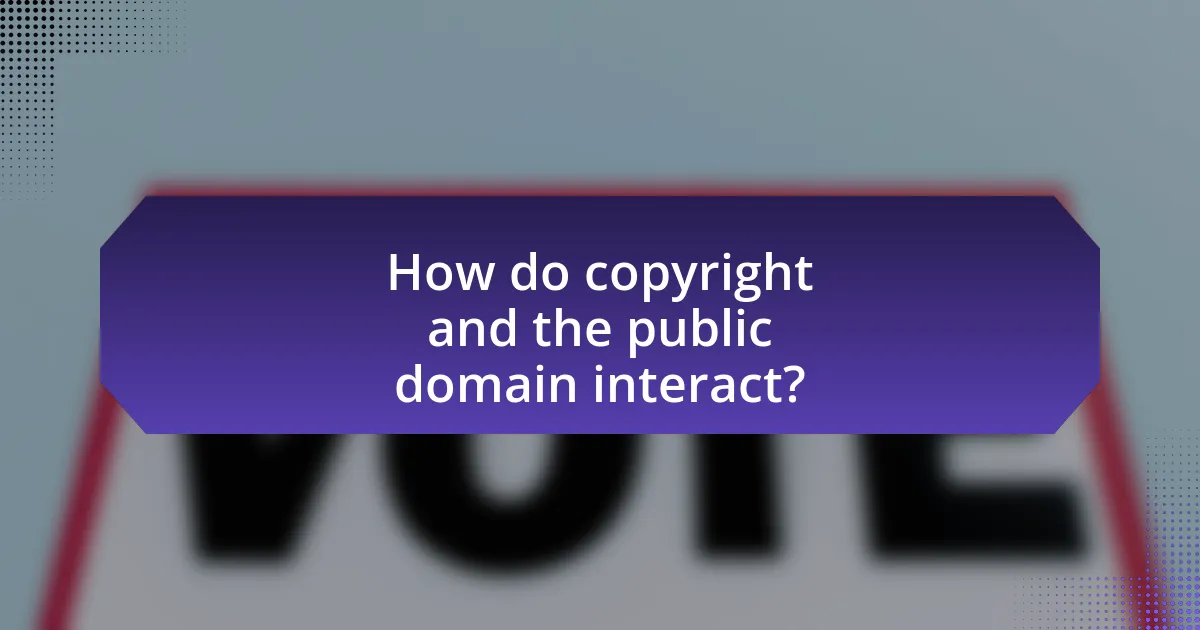
How do copyright and the public domain interact?
Copyright and the public domain interact by establishing a framework where copyrighted works can eventually enter the public domain after a specified period, allowing unrestricted access and use by the public. Copyright law grants creators exclusive rights to their works for a limited duration, typically the life of the author plus 70 years in many jurisdictions, after which the work becomes part of the public domain. This transition enables society to benefit from cultural and educational resources without legal restrictions, as evidenced by the fact that works like those of Shakespeare and Beethoven are now in the public domain, allowing free use and adaptation.
What are the implications of copyright expiration?
Copyright expiration allows works to enter the public domain, enabling unrestricted access and use by the public. This transition means that anyone can reproduce, distribute, or adapt the work without seeking permission or paying royalties. For instance, works published before 1923 are now in the public domain in the United States, allowing for widespread use in education, research, and creative projects. The implications also include fostering creativity and innovation, as new works can build upon expired copyrights without legal barriers. Additionally, copyright expiration can impact the original creators’ ability to monetize their works, as they lose exclusive rights.
How does the transition from copyright to public domain occur?
The transition from copyright to public domain occurs when the copyright term expires, allowing the work to be freely used by the public. Copyright law typically grants protection for a specific duration, which varies by jurisdiction; for example, in the United States, works created after January 1, 1978, are protected for the life of the author plus 70 years. Once this period elapses, the work enters the public domain, meaning it can be reproduced, distributed, and modified without permission or payment. This process is supported by legal frameworks established in copyright statutes, such as the Copyright Act of 1976 in the U.S., which outlines the duration of copyright protection and the conditions under which works transition to the public domain.
What are the consequences of using expired copyright works?
Using expired copyright works generally allows individuals to utilize those works without seeking permission or paying royalties. This is because once a copyright expires, the work enters the public domain, making it freely available for anyone to use. For example, works published in the United States before 1924 are now in the public domain, allowing for unrestricted access and use. However, users must ensure that the work is indeed expired and not subject to other legal protections, such as trademark or moral rights, which could impose limitations on its use.
How do international copyright laws affect the public domain?
International copyright laws significantly influence the public domain by establishing the duration and conditions under which works enter this domain. Copyright laws, such as the Berne Convention, dictate that works are protected for a minimum of the creator’s life plus 50 years, although many countries extend this period to 70 years or more. As a result, works remain under copyright protection for extended periods, delaying their entry into the public domain. This extended protection affects the availability of cultural and educational resources, as works cannot be freely used or reproduced until they expire from copyright status. Consequently, the interplay between international copyright laws and the public domain shapes access to creative works globally, impacting cultural exchange and innovation.
What are the differences in copyright laws across countries?
Copyright laws vary significantly across countries, primarily in terms of duration, scope, and enforcement mechanisms. For instance, the United States grants copyright protection for the life of the author plus 70 years, while many European countries also follow this rule but have different stipulations regarding moral rights, which protect the personal and reputational interests of authors. Additionally, some countries, like Canada, have recently updated their laws to include provisions for digital content, reflecting the evolving nature of copyright in the digital age. Enforcement practices also differ; in some jurisdictions, copyright infringement can lead to criminal penalties, while in others, it is treated primarily as a civil matter. These variations can lead to complexities in international copyright disputes, as seen in cases involving cross-border content sharing and distribution.
How do international treaties influence public domain status?
International treaties significantly influence public domain status by establishing uniform copyright standards and duration across member countries. For instance, the Berne Convention mandates that works enter the public domain after a minimum copyright term, which is typically the life of the author plus 50 years, although many countries extend this duration. This harmonization ensures that once a work’s copyright expires in one member state, it is also likely to be in the public domain in others, facilitating access and use globally. Additionally, treaties like the TRIPS Agreement set minimum standards for copyright protection, which can affect when and how works transition into the public domain, thereby shaping the landscape of intellectual property rights internationally.
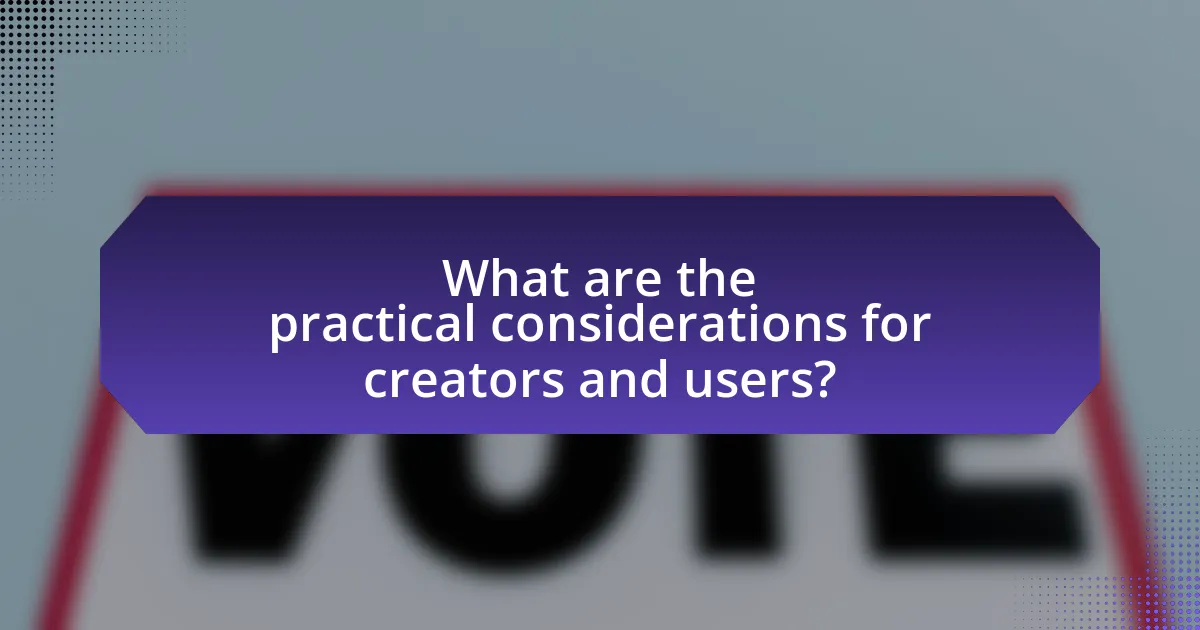
What are the practical considerations for creators and users?
Creators and users must consider copyright restrictions, licensing agreements, and the implications of fair use when engaging with creative works. Copyright law protects the rights of creators, meaning that unauthorized use can lead to legal repercussions. For creators, understanding how to license their work effectively can maximize exposure while protecting their intellectual property. Users need to be aware of the limitations imposed by copyright, including the necessity to obtain permission for certain uses or to ensure that their use falls under fair use provisions, which can vary by jurisdiction. Additionally, the distinction between public domain and copyrighted material is crucial; works in the public domain can be freely used without permission, while copyrighted works require careful navigation to avoid infringement.
How can creators protect their works while navigating the public domain?
Creators can protect their works while navigating the public domain by utilizing copyright registration, applying licenses, and understanding the limitations of public domain status. Copyright registration provides legal recognition and the ability to enforce rights against unauthorized use. Applying licenses, such as Creative Commons, allows creators to specify how others can use their works while retaining certain rights. Additionally, understanding that not all works in the public domain are free from restrictions, such as moral rights or trademark protections, helps creators safeguard their interests. These strategies ensure that creators maintain control over their works even as they engage with public domain materials.
What steps should creators take to register their copyrights?
Creators should take the following steps to register their copyrights: first, they must complete a copyright application form, which can be done online through the U.S. Copyright Office website or by submitting a paper form. Next, they need to pay the required filing fee, which varies depending on the type of work being registered. After that, creators must submit a copy of the work they wish to register, ensuring it meets the copyright eligibility criteria. Finally, they should receive a confirmation from the Copyright Office once the registration is processed, which can take several months. This process is essential as it provides legal protection and establishes a public record of the copyright, reinforcing the creator’s rights under the Copyright Act of 1976.
How can creators identify public domain works for inspiration?
Creators can identify public domain works for inspiration by utilizing resources such as Project Gutenberg, the Internet Archive, and government databases that list works whose copyrights have expired. These platforms provide access to a vast array of texts, images, and other media that are no longer under copyright protection, allowing creators to freely use and adapt these works. For example, works published in the United States before 1923 are generally in the public domain, as copyright lasts for a limited duration, typically the life of the author plus 70 years. By checking these resources and understanding copyright expiration dates, creators can effectively find and utilize public domain materials for their projects.
What best practices should users follow when using copyrighted or public domain works?
Users should always verify the copyright status of a work before use, ensuring they understand whether it is copyrighted or in the public domain. When using copyrighted works, users must seek permission from the copyright holder or rely on fair use provisions, which allow limited use without permission under specific circumstances, such as criticism, comment, news reporting, teaching, scholarship, or research. For public domain works, users can freely use, modify, and distribute the material without seeking permission, as these works are no longer under copyright protection. It is essential to attribute the original creator when using public domain works, as this practice respects the creator’s contribution and maintains transparency. Following these best practices helps users navigate copyright law effectively and avoid legal issues.
How can users ensure compliance with copyright laws?
Users can ensure compliance with copyright laws by obtaining permission from copyright holders before using their works. This includes seeking licenses for music, images, and text, as well as adhering to fair use guidelines, which allow limited use of copyrighted material without permission under specific circumstances. According to the U.S. Copyright Office, fair use is determined by factors such as the purpose of use, the nature of the copyrighted work, the amount used, and the effect on the market value of the original work. By following these steps, users can navigate copyright laws effectively and avoid legal issues.
What resources are available for understanding copyright and public domain issues?
Resources for understanding copyright and public domain issues include government websites, legal textbooks, and online courses. The U.S. Copyright Office provides comprehensive information on copyright law, including registration and public domain resources. Additionally, “Copyright Law: A Very Short Introduction” by Martin R. Gardner offers a concise overview of copyright principles. Online platforms like Coursera and edX offer courses on intellectual property law, which cover copyright and public domain topics in detail. These resources collectively provide a solid foundation for navigating copyright and public domain complexities.

